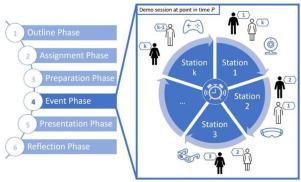Unlocking Success: Overcoming Challenges in Integrating VR/AR into School Curricula
Virtual Reality (VR) and Augmented Reality (AR) are revolutionizing the educational landscape, offering engaging and immersive learning experiences for students. However, the transition from customary teaching methods to blended environments that integrate VR/AR poses significant challenges for educators, administrators, and policymakers. In this article,we’ll explore the obstacles faced during the integration of VR and AR into school curricula and reveal actionable strategies for overcoming them,ensuring schools can unlock the full potential of immersive technology in education.
understanding the Benefits of VR/AR in Education
Before tackling integration challenges, it’s crucial to recognize why VR and AR in education are worth the investment. These cutting-edge technologies bring learning to life through:
- Enhanced Engagement: Interactive simulations and virtual environments increase student motivation and participation.
- Deeper Understanding: Complex concepts—from cell structures to historical events—become tangible, leading to improved comprehension.
- Safe, Controlled Experiments: VR allows students to experience scenarios (like chemical reactions or space exploration) too hazardous or logistically impractical to recreate in a classroom.
- Personalized Learning: Adaptive VR content tailors experiences to individual learning paces and styles.
- Accessibility: Students with disabilities can access unique experiences otherwise unavailable, fostering inclusivity.
Despite these remarkable benefits, a number of hurdles must be addressed to successfully introduce VR/AR into the classroom setting.
Key Challenges in Integrating VR/AR into School Curricula
Adopting immersive technology for schools is not without difficulty. Here are the most pressing challenges educators encounter:
- High Initial Costs: Purchasing VR headsets, AR devices, software licenses, and maintaining the necessary infrastructure demands significant upfront investment.
- Lack of Technical Expertise: Many teachers and staff lack familiarity with VR/AR platforms, creating a steep learning curve and hesitancy.
- Limited Curriculum Integration: Aligning immersive content with existing learning standards and outcomes can be complex, especially without dedicated digital curricula.
- Connectivity and Hardware Constraints: Stable internet and modern computing devices are not ubiquitous in all schools, notably in underserved areas.
- Equity and Accessibility Concerns: Ensuring that all students, regardless of background or ability, benefit equally from VR/AR is an ongoing challenge.
- Teacher Attitudes and Resistance: Shifting from established teaching practices to new tech-driven methodologies can meet with skepticism and resistance.
- Data Privacy and Safety: safeguarding student data and ensuring responsible use of VR/AR content are critical considerations.
Practical Strategies to overcome VR/AR Implementation Obstacles
-
1. Start Small and Scale Up:
Pilot immersive learning in a few classes before rolling out school-wide.This allows schools to gather feedback, troubleshoot issues, and build success stories.
-
2. Seek Partnerships and Grants:
Many edtech companies and organizations offer discounts, sponsorships, or grants for schools pioneering VR/AR projects. Look for local industry partners and tech foundations.
-
3. Provide Extensive Teacher Training:
Organize workshops, peer mentoring, and on-demand tutorials. Teachers who understand VR/AR are more likely to integrate it effectively and confidently.
-
4. Align VR/AR Activities with Learning Goals:
Collaborate with curriculum developers and use platforms offering content that meets national and state learning standards. Map VR/AR experiences to specific educational outcomes.
-
5. Choose Scalable, Flexible Technology:
When possible, opt for AR experiences that work with smartphones and tablets — devices often already available to students. Look for cross-platform VR content that doesn’t depend solely on costly proprietary hardware.
-
6. Focus on Digital Equity:
Develop a strategy to ensure all students have access to immersive technology, whether through school lending programs, device rotations, or community partnerships.
-
7. Prioritize Privacy and Safety:
Work with vendors that adhere to strict student-data privacy regulations and offer content that is safe and age-appropriate.
Case Studies: Triumphant Integration of VR/AR in Schools
The following case studies highlight real-world examples where overcoming obstacles led to impactful and successful VR/AR implementation in school curricula:
1.The VR Science Lab Initiative (New York)
- Challenge: Limited access to physical science labs in lower-income schools.
- Solution: deployment of affordable VR kits with science simulations, funded by a technology grant and phase-wise rollout across middle school grades.
- Outcome: 30% increase in science test scores, improved lab safety knowledge, and higher student engagement in STEM subjects.
2. augmented reality Textbooks in Finland
- Challenge: making interactive history and geography lessons accessible in rural schools.
- Solution: Implementation of AR-enabled textbooks that work with students’ existing tablets and smartphones.
- Outcome: notable improvement in knowledge retention and enthusiasm, with 90% of teachers reporting easier integration due to minimal new hardware requirements.
3. Teacher Training Program in the UK
- Challenge: Teacher hesitancy to adopt immersive technology.
- Solution: Introduction of an ongoing professional development program, including peer-to-peer VR lesson planning and regular digital skills workshops.
- Outcome: Teacher confidence soared, and over 75% of classes integrated at least one VR/AR module in the academic year.
First-Hand Experience: Teachers Share Their Insights
“I was hesitant at first,but after seeing how VR field trips ignited curiosity in my students—especially those usually less engaged—I am convinced this technology can bridge learning gaps.”
– Ms. Garcia, 5th Grade Teacher, California
“AR science models mean my students can interact with content on our classroom tablets. It’s especially empowering for students with learning differences, who benefit from visual and hands-on elements.”
– mr. Kohli, secondary Science Educator, London
Conclusion: Embracing the Future of Education
Successfully integrating VR/AR into school curricula is undeniably challenging, but the rewards—deeper understanding, equity, and future-ready skills—make it an essential pursuit for today’s educators and policymakers. By proactively addressing high costs, building expertise, fostering digital inclusion, and leveraging effective partnerships, schools everywhere can transform classrooms into vibrant, immersive learning environments.
As technology continues to evolve,overcoming these initial barriers will lay the groundwork for increasingly innovative teaching methods.With collaborative effort,strategic planning,and a willingness to adapt,the potential of VR/AR in education can be fully unlocked,preparing students for the dynamic world beyond the classroom.

